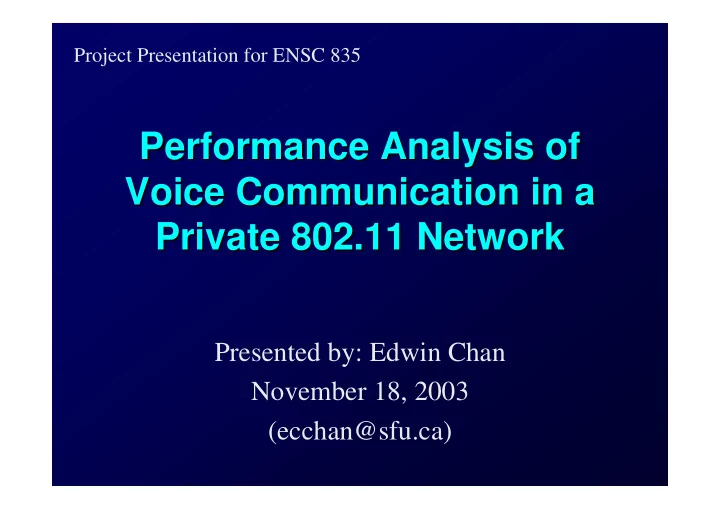

Project Presentation for ENSC 835 Performance Analysis of Performance Analysis of Voice Communication in a Voice Communication in a Private 802.11 Network Private 802.11 Network Presented by: Edwin Chan November 18, 2003 (ecchan@sfu.ca)
Outline Outline � Introduction: • What is Voice over 802.11? • Problem Definition: • Quality Quantified • Network Settings • Implementation: • ns-2 Implementation • Measurement from Traces • Future Work
Introduction What is Voice over 802.11? What is Voice over 802.11? Circuit Switched Packet Switched Wireless Nov 18, 2003 3/22
Introduction Plain Old Telephone System Plain Old Telephone System Circuit Switched Good: • Sounds good • Low delay Bad: • Unused bandwidth Nov 18, 2003 4/22
Introduction Voice over Internet Protocol Voice over Internet Protocol Packet Switched Good: • Efficient use of medium • Single network infrastructure Bad: • Delay and Jitter • Packet loss Nov 18, 2003 5/22
Introduction Voice over 802.11 Voice over 802.11 Wireless • VoIP (Voice over IP) with mobility • Suffers same quality issues as wired VoIP • Additional concerns: • Less reliable medium • Security Nov 18, 2003 6/22
Outline Outline • Introduction: • What is Voice over 802.11? � Problem Definition: • Quality Quantified • Network Settings • Implementation: • ns-2 Implementation • Measurement from Traces • Future Work
Problem Definition Quality Quantified Quality Quantified • Guidelines to measure quality objectively • Measurable factors are: • Loss – Biggest problem • Jitter – Translated into end-to-end delay • Delay – Annoyance to user Nov 18, 2003 8/22
Problem Definition How to Measure? How to Measure? • Loss – Percentage of packets dropped: 100% – (# of received packets) / (# of expected packets) • Jitter – Variation in packet arrival time: actual reception time – expected reception time • Delay – Average time of transit: packetization delay + propagation delay + queuing delay Nov 18, 2003 9/22
Problem Definition What is Good? What is Good? • Loss: Average: < 5% Ideal: < 1% • Jitter: Average: < 60 ms Ideal: < 20 ms • Delay: Average: < 150 ms Ideal: < 50 ms Nov 18, 2003 10/22
Problem Definition Network Topology Network Topology • Technology of interest: 802.11b • One Access Point (AP) Access Point serves as Private Branch Exchange (PBX) allowing access to external Central Office (CO) lines. • Multiple Mobile Stations (STA) Mobile Stations may connect to each other or connect to a CO line through the PBX. Nov 18, 2003 11/22
Problem Definition Network Parameters Network Parameters • Voice encoding algorithm Affects packet size, packetization delay, and packet rate. (G.711, G.723, and G.729) • Data rate Affects propagation delay and chance of collision (1 Mbps, 2 Mbps, 5.5 Mbps, and 11 Mbps) Nov 18, 2003 12/22
Problem Definition More Network Parameters More Network Parameters • Short preamble vs. Long preamble Affects propagation delay (96 µs vs. 192 µs) • Point Coordination Function (PCF) vs. Distributed Coordination Function (DCF) Allows better coordination within network to minimize collision. Nov 18, 2003 13/22
Outline Outline • Introduction: • What is Voice over 802.11? • Problem Definition: • Quality Quantified • Network Settings � Implementation: • ns-2 Implementation • Measurement from Traces • Future Work
Implementation ns- -2 2 ns • ns-2 version 2.26 used on Cygwin / XFree86 (validated) • Use the ns-2 2.26 all-in-one package • Get the latest cygwin setup.exe, and carefully choose required components (gcc 3, perl, awk, diff, etc…) • ./install � That’s it. • Validated (with minor adjustment) Instructions are found here (by Nicolas Christin): http://www.sims.berkeley.edu/~christin/ns-cygwin.shtml Nov 18, 2003 15/22
Implementation Point Coordination Function Point Coordination Function • Point Coordination Function support is not part of the ns-2 package. • Patch for ns-2 version 2.1b8 contributed by Anders Lindgren: http://www.sm.luth.se/~dugdale/index/software.shtml/ • Ported changes to version 2.26 Nov 18, 2003 16/22
Implementation 802.11b High Rate PHY 802.11b High Rate PHY • 802.11b specifies High Rate Physical Layer (PHY) • New modulation scheme allowing data rates of 5.5Mbps and 11Mbps. 8-chip complementary code keying (CCK) Same channel bandwidth as 802.11 • Short preamble Nov 18, 2003 17/22
Implementation Application Layer Application Layer • Real-time Transport Protocol (RTP) and Real-time Transport Control Protocol (RTCP) • Both already implemented in ns-2 • Group based sessions • Use simple Constant Bit Rate (CBR) agents to simulate traffic • Different payload sizes according to encoding algorithm Nov 18, 2003 18/22
Implementation Measurement from Traces Measurement from Traces • ns trace files need to be analyzed by separate script • Perl scripts are used to calculate • Loss • Jitter • Delay • Output can be visualized through xgraph Nov 18, 2003 19/22
Outline Outline • Introduction: • What is Voice over 802.11? • Problem Definition: • Quality Quantified • Network Settings • Implementation: • ns-2 Implementation • Measurement from Traces � Future Work
Future Work Future Work • Dependent on the public release of the new specifications: 802.11g and 802.11e • 802.11g specifies extended rates of up to 54Mbps using the same 2.4GHz band as 802.11b. • 802.11e specifies Quality of Service extensions. Nov 18, 2003 21/22
References References 1. IEEE Std 802.11-1999, IEEE Standard for Local and Metropolitan Area Networks: Wireless LAN Medium Access Control (MAC) and Physical Layer (PHY) Specifications: http://standards.ieee.org/getieee802/download/802.11-1999.pdf. 2. IEEE Std 802.11b-1999, Supplement to IEEE Standard 802.11, 1999 Edition: Higher-Speed Physical Layer Extension in the 2.4 GHz Band: http://standards.ieee.org/getieee802/download/802.11b-1999.pdf. 3. H. Schulzrinne et al., "RTP: A Transport Protocol for Real-Time Applications," RFC 3550, IETF, July 2003: http://www.ietf.org/rfc/rfc3550.txt. 4. H. Schulzrinne et al., "RTP Profile for Audio and Video Conferences with Minimal Control," RFC 3551, IETF, July 2003: http://www.ietf.org/rfc/rfc3551.txt. 5. "IP Telephony Design Guide - An Alcatel White Paper," Alcatel, 2003. Nov 18, 2003 22/22
~ End ~
Recommend
More recommend